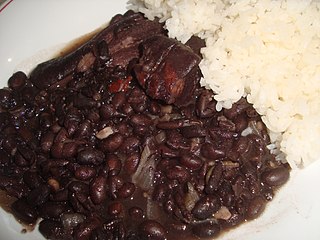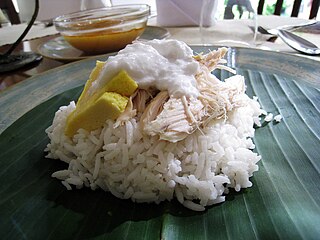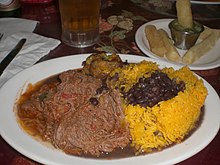
Costa Rican cuisine is known for being mostly mild, with high reliance on fruits and vegetables. Rice and black beans are a staple of most traditional Costa Rican meals, often served three times a day. Costa Rican fare is nutritionally well rounded, and nearly always cooked from scratch from fresh ingredients. Owing to the location of the country, tropical fruits and vegetables are readily available and included in the local cuisine.

Puerto Rican cuisine consists of the cooking style and traditional dishes original to Puerto Rico. It has been primarily influenced by the ancestors of the Puerto Rican people: the indigenous Taínos, Spanish colonizers, and sub-Saharan African slaves. As a territory of the United States, the culinary scene of Puerto Rico has also been moderately influenced by American cuisine.

Fried rice is a dish of cooked rice that has been stir-fried in a wok or a frying pan and is usually mixed with other ingredients such as eggs, vegetables, seafood, or meat. It is often eaten by itself or as an accompaniment to another dish. Fried rice is a popular component of East Asian, Southeast Asian and certain South Asian cuisines, as well as a staple national dish of Indonesia. As a homemade dish, fried rice is typically made with ingredients left over from other dishes, leading to countless variations. Fried rice first developed during the Sui Dynasty in China.

Latin American cuisine is the typical foods, beverages, and cooking styles common to many of the countries and cultures in Latin America. Latin America is a highly racially, ethnically, and geographically diverse with varying cuisines. Some items typical of Latin American cuisine include maize-based dishes arepas, empanadas, pupusas, tacos, tamales, tortillas and various salsas and other condiments. Sofrito, a culinary term that originally referred to a specific combination of sautéed or braised aromatics, exists in Latin American cuisine. It refers to a sauce of tomatoes, roasted bell peppers, garlic, onions and herbs. Rice, corn, pasta, bread, plantain, potato, yucca, and beans are also staples in Latin American cuisine.

Rice pudding is a dish made from rice mixed with water or milk and other ingredients such as cinnamon, vanilla, and raisins.

The milanesa is a variation of the Lombard veal Milanese, or the Austrian Wiener schnitzel, where generic types of breaded cutlet preparations are known as a milanesa.

Nicaraguan cuisine includes a mixture of Mesoamerican, Chibcha, Spanish, Caribbean, and African cuisine. Despite the blending and incorporation of pre-Columbian, Spanish and African influences, traditional cuisine differs from the western half of Nicaragua to the eastern half. Western Nicaraguan cuisine revolves around the Mesoamerican diet of the Chorotega and Nicarao people such as maize, tomatoes, avocados, turkey, squash, beans, chili, and chocolate, in addition to potatoes which were cultivated by the Chibcha people originating from South America and introduced meats like pork and chicken. Eastern Nicaraguan cuisine consists mostly of seafood and coconut.

Moros y Cristianos is a traditional Cuban dish served both in homes and in restaurants. It is the Cuban version of rice and beans, a dish found throughout Latin America, the Caribbean, and in the Southern United States.

Salvadoran cuisine is a style of cooking derived from the nation of El Salvador. The indigenous foods consist of a mix of Amerindian cuisine from groups such as the Lenca, Pipil, Maya Poqomam, Maya Chʼortiʼ, Alaguilac and Cacaopera peoples. Many of the dishes are made with maize (corn). There is also heavy use of pork and seafood. European ingredients were incorporated after the Spanish conquest.

Rice and beans, or beans and rice, is a category of dishes from many cultures around the world, whereby the staple foods of rice and beans are combined in some manner. The grain and legume combination provides several important nutrients and many calories, and both foods are widely available. The beans are usually seasoned, while the rice may be plain or seasoned. The two components may be mixed together, separated on the plate, or served separately.

Colombian cuisine is a compound of the culinary traditions of the six main regions within Colombia. Colombian cuisine varies regionally and is particularly influenced by Indigenous Colombian, Spanish, and African cuisines, with slight Arab influence in some regions. As one of the most biodiverse countries in the world, Colombia has one of the widest varieties of available ingredients depending on the region.

Dominican cuisine is made up of Spanish, indigenous Taíno, Middle Eastern, African, Cuban, Puerto Rican and Haitian influences. The most recent influences in Dominican cuisine are from the British West Indies and China.
Panamanian cuisine is a mix of Spanish, Indigenous, and African techniques, dishes, and ingredients, reflecting its diverse population. Since Panama is a land bridge between two continents, it has a large variety of tropical fruits, vegetables and herbs that are used in native cooking.

Most traditional foods in Guatemalan cuisine are based on Maya cuisine, with Spanish influence, and prominently feature corn, chilies and beans as key ingredients. Guatemala is famously home to the Hass avocado.

Coconut rice is a dish prepared by cooking white rice in coconut milk or coconut flakes. As both the coconut and the rice-plant are commonly found in the tropics all around the world, coconut rice, too, is found in many cultures throughout the world, spanning across the equator from Southeast Asia, the Indian subcontinent, South America, Central America, West Africa, East Africa, the Caribbean and Oceania.

The cuisine of Veracruz is the regional cooking of Veracruz, a Mexican state along the Gulf of Mexico. Its cooking is characterized by three main influences—indigenous, Spanish, and Afro-Cuban—per its history, which included the arrival of the Spanish and of enslaved people from Africa and the Caribbean. These influences have contributed many ingredients to the cooking including native vanilla, corn and seafood, along with rice, spices and tubers. How much the three mix depending on the area of the state, with some areas more heavily favoring one or another. The state has worked to promote its cuisine both in Mexico and abroad as part of its tourism industry.


















